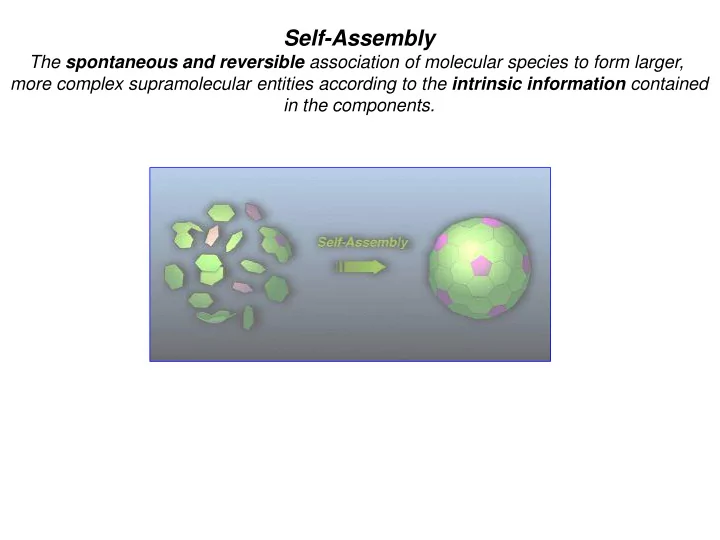

Self-Assembly The spontaneous and reversible association of molecular species to form larger, more complex supramolecular entities according to the intrinsic information contained in the components.
Metal-Ligand Interaction
Metal as connector : - labile M-L interaction (kinetic) - stable compound (thermodynamic) - highly directional with many geometries available Metal as functional group : - redox active (electron transfer) - UV-vis active (color) - photo active (phosphorescence) - magnetic properties
cis Classical metals used: Pd(II), Pt(II), Cu(I), Cu(II), Re(I), Co(II), Fe(II), Ag(I), Zn(II), Ru(II) … cis trans mer- fac-
Directonal Bonding Approach M = bb acido, L = bb basico, definiti secondo il numero e geometria relativa dei siti acidi e basici
Specie poligonali 2D
Triangoli Molecolari
Square = Triangle endothermic H < 0 S < S < 0 Solvent Concentration Temperature
Directonal Bonding Approach M = bb acido, L = bb basico, definiti secondo il numero e geometria relativa dei siti acidi e basici
Gabbie Molecolari M 6 L 4 d ca. 11 Å Portali 8 Å
Molecular Paneling
carborano 1-adamantanolo
difenilmetano cis -azobenzene cis -stilbene 4,4’ -dimetossi-dibenzoile
tri- tert -butilbenzene tetrabenzilsilano
1:1 1:2 1:4 1:8 M 6 L 4 / adamantancarbossilato 4 Effetto allosterico!
dibenzoile
6:2:3
Stabilizzazione di intermedi reattivi: alcossi-silani ciclici Ship in a Bottle
Stabilizzazione di intermedi reattivi: Oligomerizzazione di tri alcossi-silani
Fotodimerizzazioni 2+2 acenaftileni naftochinoni
acenaftilene controllo stereochimica, [ ] 2mM resa > 98% benzene: [ ] 150mM, 3h, resa 40%, no stereoselettività
1-metil-acenaftilene Controllo regiochimica, [ ] 2mM resa > 98%
naftochinone controllo stereochimica, [ ] 2mM resa > 98% benzene: [ ] > >, t > >, resa 25%, 21% anti
M 4 L 6 , (Ga 3+ , Fe 3+ ; biscatecol-amidi) 12 - , , , 300-350 Å Stabilizzazione di cationi organici
Supramolecular Catalysis of a Unimolecular Transformation: Aza ‐ Cope Rearrangement within a Self ‐ Assembled Host Left: A schematic view of the [G ⊂ M 4 L 6 ] (G=guest) supramolecular tetrahedral assembly, looking down the C 3 ‐ axis. For clarity only one ligand is drawn, the other ligands are represented as sticks. Middle: CAChe model of [NPr 4 ⊂ Fe 4 L 6 ] 11 − , the guest molecule is shown in a space ‐ filling view, the hydrogen atoms are omitted for clarity. Right: The same CAChe model as in the middle, now with host and guest in space filling view. This representation shows that the guest molecule is not exposed to the assembly exterior, but rather is tightly surrounded by the host. Supramolecular Catalysis of a Unimolecular Transformation: Aza ‐ Cope Rearrangement within a Self ‐ Assembled Host, Volume: 43, Issue: 48, Pages: 6748-6751, First published: 08 December 2004, DOI: (10.1002/anie.200461776)
Supramolecular Catalysis of a Unimolecular Transformation: Aza ‐ Cope Rearrangement within a Self ‐ Assembled Host Top: A general reaction scheme of the 3 ‐ aza ‐ Cope rearrangement. Starting from the enammonium cation A , [3,3] sigmatropic rearrangement leads to iminium cation B , which then hydrolyzes to the aldehyde, C . Bottom: 1 H NMR spectrum of [ 1 ⊂ Ga 4 L 6 ] 11 − ( 1 : R 1 , R 2 , R 3 =H). The observed upfield shift of guest resonance signals illustrates the close contact between host and guest. Supramolecular Catalysis of a Unimolecular Transformation: Aza ‐ Cope Rearrangement within a Self ‐ Assembled Host, Volume: 43, Issue: 48, Pages: 6748-6751, First published: 08 December 2004, DOI: (10.1002/anie.200461776)
Supramolecular Catalysis of a Unimolecular Transformation: Aza ‐ Cope Rearrangement within a Self ‐ Assembled Host Table 1. Rate constants for free ( k free ) and encapsulated ( k encaps ) rearrangements (measured at 50 °C) and their acceleration factors. k free k encaps Accelerat Substrate R 1 R 2 R 3 [ × 10 −5 [ × 10 −5 ion s −1 ] s −1 ] 1 H H H 3.49 16.3 5 2 Me H H 7.61 198 26 3 H Et H 3.17 446 141 4 H H Et 1.50 135 90 5 H n Pr H 4.04 604 150 6 H H n Pr 1.69 74.2 44 7 H i Pr H 0.37 316 854 Supramolecular Catalysis of a Unimolecular Transformation: Aza ‐ Cope Rearrangement within a Self ‐ Assembled Host, Volume: 43, Issue: 48, Pages: 6748-6751, First published: 08 December 2004, DOI: (10.1002/anie.200461776)
Supramolecular Catalysis of a Unimolecular Transformation: Aza ‐ Cope Rearrangement within a Self ‐ Assembled Host The 2D NOESY spectrum of [ 3 ⊂ Ga 4 L 6 ] 11 − in a D 2 O/MeOD mixture (70:30) recorded at − 10 °C, mixing time 100 ms. Indicated in red are selected NOEs. The correlation between Me and Me at the two distal ends of the molecule demonstrates the cavity's enforcement of a compressed and folded guest conformation. H n =naphthyl protons, H c =catechol protons. Supramolecular Catalysis of a Unimolecular Transformation: Aza ‐ Cope Rearrangement within a Self ‐ Assembled Host, Volume: 43, Issue: 48, Pages: 6748-6751, First published: 08 December 2004, DOI: (10.1002/anie.200461776)
Supramolecular Catalysis of a Unimolecular Transformation: Aza ‐ Cope Rearrangement within a Self ‐ Assembled Host Proposed catalytic cycle for the cationic 3 ‐ aza ‐ Cope rearrangement, see text for details. Supramolecular Catalysis of a Unimolecular Transformation: Aza ‐ Cope Rearrangement within a Self ‐ Assembled Host, Volume: 43, Issue: 48, Pages: 6748-6751, First published: 08 December 2004, DOI: (10.1002/anie.200461776)
Fig. 1 Synthesis of tetrahedral cage 1 and subsequent incorporation of P4.
Fig. 2 Crystal structure of P4 ⊂ 1.
Fig. 3 Extraction of P4 from 1 by n-heptane is not possible, whereas replacing P4 with another suitable guest (benzene or cyclohexane) results in the facile removal of P4 into the organic solvent.
Recommend
More recommend